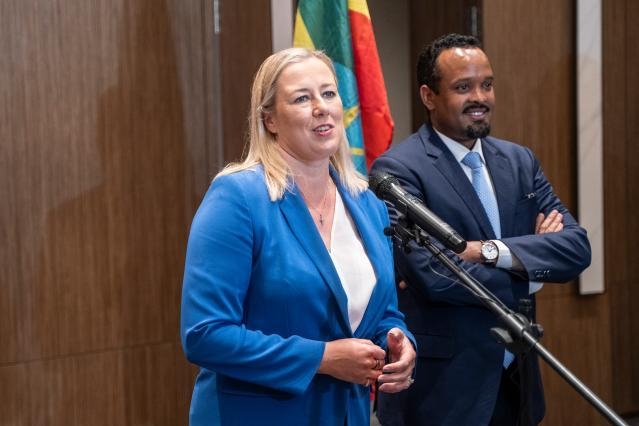Canada has experienced an unprecedented wildfire season in 2023. People’s experiences with any disaster event are influenced by social- and place-based vulnerabilities. For example, where you live affects your exposure to different hazards including wildfires and floods.
Pre-existing social vulnerabilities contribute to some populations having disproportionate impacts from these events, in both the short and long term. Social vulnerability factors that have a demonstrated effect on people’s experience with disasters include income, health, disability, age, race, and gender. These factors also intersect in ways that increase vulnerability for certain populations.
Evidence suggests gender-based violence increases during disasters and in the years that follow. Further, the risk for women and LGBTQI populations is heightened when sheltering in place or evacuation from a community is required.
Evidence of gender-based violence during and after disasters can be reflected in increased calls from women to police and domestic violence helplines. However, it is estimated that 78 per cent of cases of sexual assault in Canada are not reported for a variety of reasons.
It is important to recognize that social vulnerabilities are not inherent individual traits, rather vulnerability stems from historic inequities over time that impact access to resources and marginalize people.
Government preparedness for and responses to disasters must consider and address how social vulnerabilities increase disaster risk and adverse outcomes for some populations.
(Shutterstock)
Gaps in emergency management planning
My research examines how social vulnerabilities, gender and gender-based violence are addressed in government plans for responding to disasters and pandemics. In my research, I found that federal, provincial, territorial and local government emergency management plans in Canada acknowledge how social vulnerabilities contribute to the differential impacts of hazard events for households and communities.
Importantly, the federal government recently published two reports examining how social vulnerability contributes to disaster risk: the National Risk Profile and the report on Social Vulnerability to Natural Hazards in Canada.
However, my research also found these reports and plans do not address how gender influences the direct and indirect impacts of disasters, including the increase in gender-based violence during and following disasters.
While federal, provincial and territorial governments have made commitments to addressing gender inequities and the use of gender-based analysis tools such as GBA+, I found limited reference or commitment to the use of these tools.
GBA+ tools examine how gender intersects with other identity factors, such as age, ethnicity and income to differentiate experiences of women, men and gender diverse populations.
Public Safety Canada’s Departmental Plan references GBA+ when addressing emergency management. However, the plans address social vulnerability more generally and no commitments are made to address gender specifically.
The only identified government funded report addressing gender and disaster in the Canadian context was a 2008 report by the Public Health Agency of Canada.
The federal and some but not all provincial and territorial governments took actions during the pandemic to address the increase in gender-based violence. However, there has been no concerted effort by Canadian governments to address the gendered impacts of disasters more generally.

THE CANADIAN PRESS/Darryl Dyck
Gender-based violence and disasters
There is an established body of research on gender-based violence during Australian bushfires. Researchers found domestic violence occurred in households where a woman had previously experienced violence, as well as in households were there had been stable non-violent relationships.
Further, those experiencing violence noted an increase of the severity of the violence following the disasters. These same patterns were noted in the pandemic in Canada.
The Australian research also found women’s unemployment or homelessness during a disaster was exploited by men who return under the guise of offering assistance. In other instances, men’s behaviour during disaster was excused by counsellors or police because of the stresses brought on by a disaster. The dismissal of violence in the context of a disaster harms women.
Another concern is that supports like counselling centres, women’s shelters and sexual assault centres can be disrupted during a disaster. In the recent evacuation of Yellowknife, all these services would likely have been impacted. Further, communication infrastructure is also impacted by disasters, which can limit the ability to call for help.
The Canadian Women’s Foundation recently supported the development of guidance to help these organizations prepare for service disruptions in the event of a disaster.
A call to action
We have a moral and ethical imperative to address the inequitable effects of disasters within society.
Recommendations on how to address the gendered impacts of disasters, including gender-based violence, include The Gender Handbook for Humanitarian Action, Guidelines for Integrating Gender-Based Violence Interventions in Humanitarian Action, the Red Cross Minimum Standard Commitments to Gender and Diversity in Emergency Programming and the UN’s Minimum Standards for Prevention and Response to Gender-based Violence in Emergencies.
Australia has made significant investments in addressing the gendered impacts of disasters. Their process offers an example of what is needed in Canada to advance gender and disaster practice.
The mandate to address gender inequities in Canada is already in place, as are plans to address gender-based violence. There is an urgent imperative to bring the work addressing gender-based inequity and violence into emergency management practice. These efforts need to be led by all orders of government and integrated into their action plans for improving emergency management practices in Canada.
Experts on the gendered impacts of disasters must become part of the emergency response effort. In addition to integrating gender analysis in planning activities, rapid gender analysis needs to be conducted at the outset of a disaster and throughout the recovery period.
Further, emergency management organizations need to work closely with counselling centres, women’s shelters and sexual assault services to ensure they have the capacity to respond to disasters. These organizations must be recognized as an essential service when disasters occur.




